Some resemble Jacob's Ladders; others resemble Irish Chains, but all these blocks have patterns with diagonal effects.
 Road to Oklahoma  Crockett Cabin Quilt  The Tail of Benjamin's Kite  Double Hour Glass  The Contrary Wife Quilt 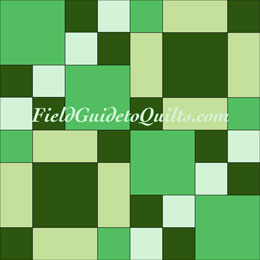 Four Squares 
Spanish Squares 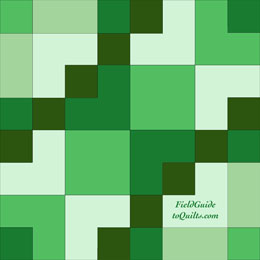 Steps to Glory  Pussy in the Corner 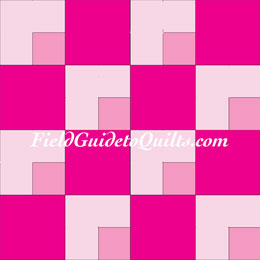 Puss in the Corner  Arkansas Cross Roads  Cotton Reels 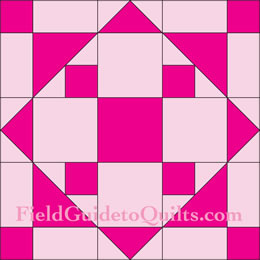 Fanny's Favorite
See also:
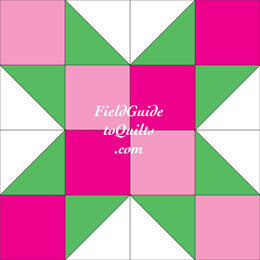 The Winged Four Patch |
|
Road to Oklahoma
 Road to Oklahoma Road to Oklahoma
  Road to Oklahoma Road to Oklahoma
LAC #239
1897
Road to Oklahoma is a little family of triplets, born separately between 1897 and 1956 but identical nonetheless.
As usual, the first publisher was the Ladies Art Company (1897, #239). The second was the Kansas City Star, in 1929 (and 1947 and 1956). Nancy Cabot was the third designer to offer this two-color block to her readers, in a 1937 Chicago Tribune.
In the graphic at left, which we redrew from an LAC catalog, we reversed the light and dark colors to show the seams.
Truth be told, the seam placement wasn't exactly the same in the LAC's and Cabot's blocks, but color placement makes the two look alike. Arkansas Cross Roads, below, uses the same diagram as Cabot's Road to Oklahoma but looks nothing like either.
The Star was so in love with the name that it published two more, entirely different, blocks using it:  and and
|
|
Crockett Cabin Quilt
 Crockett Cabin Quilt
Block: Marshall. 1972
Name: Wood, 1999 Crockett Cabin Quilt
Block: Marshall. 1972
Name: Wood, 1999 Crockett Cabin Quilt Crockett Cabin Quilt
The bowtie seams are put to much better use in this block, which is known by a relatively recent name, Crockett Cabin Quilt. The earliest cite we've seen for the name is Wood's The Practical Encyclopedia of Sewing (1999).
The block is also called Road to California on the web site quilterscache.com — we're not sure why.
The name Road to Oklahoma predates the others by 25 years or more (Martha Marshall's Quilts of Appalachia, 1972, per Brackman).
So why are we using the newest name? Because it's by far the most memorable.
It's particularly memorable to us: Our personal ancestors once lent Davey Crockett some money and never got it back. It's just one more reason to remember the Alamo.*
Our graphic takes its color cues from Maggie Malone's 5,500 Quilt Block Designs (2003). We've also seen it with the bowties in a third color.
We're not sure of the color values in the original block.
* In the USA, debts die with the debtor.
|
|
The Tail of Benjamin's Kite
   
   
   
    The Tail of Benjamin's Kite
The Tail of Benjamin's Kite  The Tail of Benjamin's Kite
Khin, 1988 The Tail of Benjamin's Kite
Khin, 1988
This variation is from Yvonne Khin's Collector's Dictionary of Quilt Names and Patterns, as are the two alternative names. Click here for another variation, more often known as The Trail of the Covered Wagon, that we've put on the Jacob's Ladder page:  |
|
Double Hour Glass
 Double Hour Glass
Cabot, 1933 Double Hour Glass
Cabot, 1933
Nancy Cabot's name for this block, Double Hour Glass, is from 1933, and is the earliest name we've seen for blocks using this layout: 
The rest of our block variations are from Barbara Brackman's Encyclopedia of Pieced Quilt Patterns. For Attic Window and Road to California (Gutcheon, 1973) click here:  |
|
The Contrary Wife Quilt
 Contrary Wife
KCS, 1941 Contrary Wife
KCS, 1941
The four blocks made from the pattern are all slightly different, and we've seen the original of only this one, Contrary Wife Quilt.
Contrary Wife followed Contrary Husband, published three years earlier in the Kansas City Star. That block usually goes by the name Box Quilt Pattern:  |
|
Four Squares
 Four Squares
Cabot, 1937 Four Squares
Cabot, 1937
| Four-patches in a four-patch |
 |
| "Nine Patch" block |
Grn.jpg) |
The Nine Patch block, which is based on a 4 x 4 square grid (and thus is not a "9-patch" at all), is covered here: Grn.jpg) |
|
Spanish Squares
   
Spanish Squares
 Spanish SquaresLAC #66 Spanish SquaresLAC #66
1897
Problem is, the quilt would be gigantic. Even with squares just 1" wide, a single block would cover a queen bed with a 20" drop on each side, and that's if you didn't add borders.
Back in the day, they used narrower beds, more like three-quarter size. Nobody uses those nowadays who doesn't own an antique bed or an RV. Three-quarter beds are 54" x 75." That's a 24" drop on each side!
Perhaps Cabot was thinking of a custom-made quilt for a boarding house. A quilt with four of these blocks, like our mockup at right, would be 200" across.
Our granddad said that the only thing he was superstitious about was sleeping 13 in a bed, so the quilt in our mockup would give him the fantods.
You have to hand it to the Depression-era quilters who tackled this one. |
|
Steps to Glory
  Steps to Glory Steps to Glory
Cabot, 1937 Published in 1937, Steps to Glory is credited to Nancy Cabot of the Chicago Tribune.
We're quite partial to it in yellow and blue.
We've posted a diagram; click on the "Make It!" icon to see it.
|
|
Pussy in the Corner
   
   
   
   
Pussy in the Corner
 Pussy in the Corner
Grandmother Clark Pussy in the Corner
Grandmother Clark
ca. 1931-1932
The block at left is based on the Kansas City Star version, which specified a print for the plain blocks. |
|
Puss in the Corner
   
   
   
   
Puss in the Corner
 Puss in the Corner
Cabot, 1938 Puss in the Corner
Cabot, 1938
In the illustration,
the small medium-pink piece was inset into the light-pink piece without seams, so we can't tell whether that part was a four-patch or a three-piece block with a mitered corner.
What's the difference? Here's a four-patch:  Here's a mitered corner: Here's a mitered corner: 
Almost all quilters aim to have mitered corners in the outer borders of their quilts, but you don't see many mitered blocks per se. If we had to guess, we'd say that Puss In the Corner's lighter pink blocks were made as four-patches. We don't know for sure.
Here's the block as a four-patch:  With a mitered corner: With a mitered corner:  And finally, with an arrangement that has no name that we know of:
And finally, with an arrangement that has no name that we know of: 
|
|
Arkansas Cross Roads

 Arkansas Cross Roads
KCS, 1941 Arkansas Cross Roads
KCS, 1941
Oddly, the block makes no use of the seams that create bowties in two quarters of the block. The instructions you'll go to when you click the "Make It!" icon leaves those seams out entirely.
If you'd like to play with the colors for those bowties, use the Road to Oklahoma diagram (see the violet "Make It!" icon above). |
|
Cotton Reels
   
   
   
   
Cotton Reels
 Cotton Reels Cotton Reels
Golden Hands, #10
In her Encyclopedia of Pieced Quilt Patterns, Barbara Brackman ascribes this block to a publication called "Golden Hands #10." We can't add much, if anything, to that.
|
|
Fanny's Favorite
   
   
   
   
Fanny's Favorite
 Puss in the CornerLAC #464 Puss in the CornerLAC #464
ca. 1922
From the mockup, we'd have to say that on this page, we've saved the best for last. Do you agree?
It is an eight-patch.
*http://ladiesartcompany.com/?page_id=94; this is the website for Connie Chunn, researcher.
| |
 More diagonals
More diagonals More diagonals
More diagonals